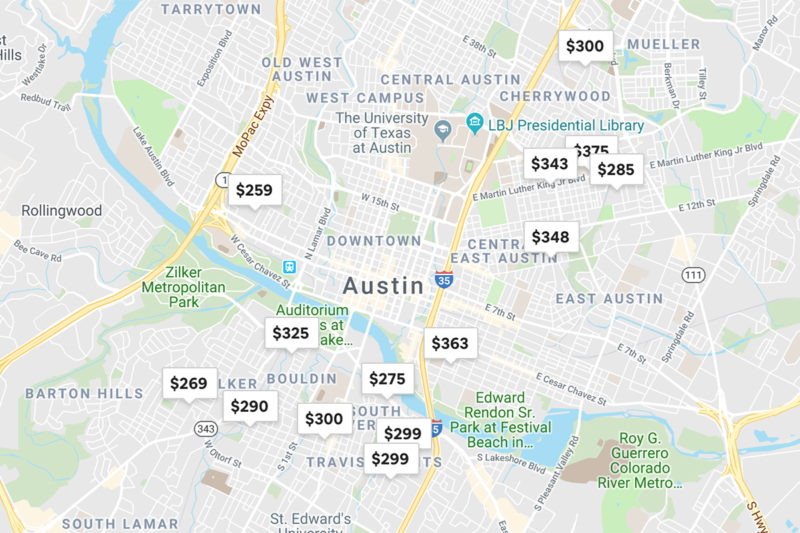Short-Term Austin Rentals Point to Longer-Term Problems
By Robert Larkin
Reporting Texas

Airbnb listings are seen on a map of Austin, Texas. Image Credit: Google Maps via Airbnb
South by Southwest returns to Austin on March 8, promising to bring in tens of thousands of visitors to enjoy music, films and tech-savvy conference panels. And thanks to SXSW’s rapid-fire growth, Airbnb, HomeAway and others businesses in the short-term rental market stand to reap big gains — and big complaints from Austin residents.
The city of Austin strengthened rules policing short-term rentals in 2016, but a rising tide of complaints about noise and others nuisances has kept the spotlight on misbehaving renters. Nearly forgotten in the kerfuffle has been what critics say are upward pressures the rentals put on housing prices in Austin, the most popular short-term rental destination in Texas.
In 2016, the most recent year for which statistics are available, the median price for Airbnb rentals during SXSW was $600 per night, according to the data sourcing website DataFiniti.co. Between 2016 and 2018, the number of SXSW participants rose from about 343,000 to approximately 425,000.
Austin Demographer Ryan Robinson says the problem isn’t the booming business in short-term rentals — it’s the uneven distribution of rental locations.
“If you could have one short-term rental in every neighborhood that would be a beautiful thing,” Robinson said. “You’d be introducing diversity and new faces into neighborhoods. But the reality is the phenomenon itself is highly clustered.”
Short-term rentals tend to be located in higher-priced residential neighborhoods within a five-mile radius of Lady Bird Lake. The rentals contribute to higher home prices by removing available stock from selected markets, Robinson said. That puts pressure on homes prices in a market where inventory lags behind the city’s rapid population growth overall.
At present, market leader Airbnb has 11,919 available homes in the Austin area, according to the database Inside Airbnb, with a large majority in zip codes in the central city.
Not everyone is seeing negative effects. Realty Austin realtor James Watson says he hasn’t personally witnessed buyers disrupt the market for the purpose of operating short-term rentals, but he acknowledged it could be an issue.
“I can’t imagine someone buying a $675,000 home in Hyde Park that needs work and turning it into a [short-term rental] because of the cost itself,” Watson said. “But I think it could [be an issue]. Every little element that pulls out inventory does increase prices.”
The effect on the housing market is the latest wrinkle in an ongoing battle over the rental that has roiled Texas for a decade, particularly Austin. According to the Austin Code Department, short-term rental citations have grown from six in 2016 to 94 in 2018; short-term rental complaints increased from 959 to more than 1,500 during the same time period.
Stakeholders at the state level, meanwhile, have fought to stave off restrictions. Last year, the Texas Supreme Court sided with San Antonio resident Kenneth Tarr after his neighbors claimed he was violating the neighborhood association’s restrictions on property use by renting out his home through short-term rental websites.
In 2017, State Sen. Kelly Hancock, R-North Richland Hills, filed a bill that would have prevented cities from banning the rentals. That bill died in conference committee and, at least so far, state lawmakers haven’t pressed the issue in the current legislative term.
Meanwhile, Austin is pressing ahead with plans to enforce an ordinance that would phase out full-time rentals by 2022 in cases where the owner doesn’t live on property. Still, Robinson hopes the city will go further in dealing with the issue.
“We haven’t been nearly as strong as I’d like to see,” Robinson said. In Austin, he said, officials “spend so much time enforcing zoning code, and yet [if] you want to operate a mini-hotel in the middle of neighborhood — go to town.” Robinson would like to see that contradiction remedied.